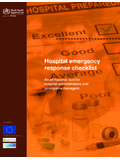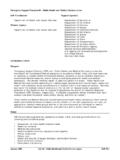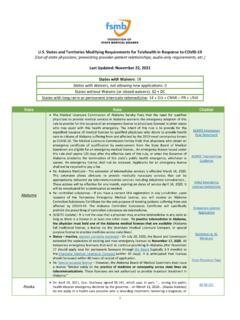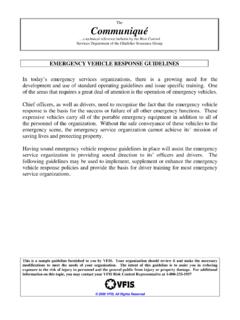Transcription of FactSheet - Occupational Safety and Health Administration
1 Directing all emergency activities includingevacuation of personnel. Ensuring that outside emergency services arenotified when necessary. Directing the shutdown of plant operationswhen response TeamsEmergency response team members should bethoroughly trained for potential crises and physi-cally capable of carrying out their duties. Teammembers need to know about toxic hazards in theworkplace and be able to judge when to evacuatepersonnel or when to rely on outside help ( ,when a fire is too large to handle). One or moreteams must be trained in: Use of various types of fire extinguishers. First aid, including cardiopulmonary resuscita-tion (CPR) and self-contained breathing appara-tus (SCBA). Requirements of the OSHA bloodbornepathogens standard. Shutdown procedures. Chemical spill control procedures. Search and emergency rescue procedures. Hazardous materials emergency ActivitiesEffective emergency communication is vital. Analternate area for a communications center otherthan management offices should be established inthe plans, and the emergency response coordina-tor should operate from this center.
2 Managementshould provide emergency alarms and ensurethat employees know how to report updated list of key personnel and off-duty telephone numbers should be required by some Occupational Safety and Health Administration standards, firms withmore than 10 employees must have a writtenemergency action plan; smaller companies maycommunicate their plans orally. Top managementsupport and the commitment and involvement ofall employees are essential to an effective emer-gency action should review plans with employeeswhen initially put in place and re-evaluate andamend the plan periodically whenever the planitself, or employee responsibilities, procedures, including the handling ofany toxic chemicals, should include: Escape procedures and escape route assignments. Special procedures for employees who performor shut down critical plant operations. Systems to account for all employees after evac-uation and for information about the plan. Rescue and medical duties for employees whoperform them.
3 Means for reporting fires and other of CommandThe employer should designate an emergencyresponse coordinator and a backup coordinator may be responsible for plant-wide operations, public information and ensuringthat outside aid is called. Having a backup coordi-nator ensures that a trained person is alwaysavailable. Employees should know who the designated coordinator is. Duties of the coordina-tor and employer include: Determining what emergencies may occur andseeing that emergency procedures are devel-oped to address each and Responding to Workplace EmergenciesNobody expects an emergency or disaster. Yet emergencies and disasters canstrike anyone, anytime, anywhere. Employers should establish effective safetyand Health management systems and prepare their workers to handle emergen-cies before they for personnel following evacuation iscritical. A person in the control center should notify police or emergency response team mem-bers of persons believed security procedures can prevent unau-thorized access and protect vital records andequipment.
4 Duplicate records of essentialaccounting files, legal documents and lists ofemployee relatives to be notified in case ofemergency can be kept at off-site employee needs to know details of theemergency action plan, including evacuationplans, alarm systems, reporting procedures forpersonnel, shutdown procedures, and types ofpotential emergencies. Any special hazards, suchas flammable materials, toxic chemicals, radioac-tive sources or water-reactive substances, shouldbe discussed with employees. Drills should beheld at random intervals, at least annually, andshould include outside police and fire must be conducted at least annually andwhen employees are hired or when their jobchanges. Additional training is needed when newequipment, materials or processes are introduced,when the layout or design of the facility changes,when procedures have been updated or revised,or when exercises show that employee perform-ance is ProtectionEmployees exposed to or near accidental chemi-cal splashes, falling objects, flying particles,This is one in a series of informational fact sheets highlighting OSHA programs, policies or standards.
5 It does not impose any new compliance requirements. For a comprehensive list of compliance requirements of OSHA standards or regulations, refer to Title 29 of the Code of FederalRegulations. This information will be made available to sensory impaired individuals upon voice phone is (202) 693-1999; teletypewriter (TTY) number: (877) atmospheres with inadequate oxygen ortoxic gases, fires, live electrical wiring, or similaremergencies need appropriate personal AssistanceFirst aid must be available within 3 to 4 minutes ofan emergency . Worksites more than 3 to 4 min-utes from an infirmary, clinic, or hospital shouldhave at least one person on-site trained in first aid(available all shifts), have medical personnel readi-ly available for advice and consultation, and devel-op written emergency medical is essential that first aid supplies are available tothe trained first aid providers, that emergencyphone numbers are placed in conspicuous placesnear or on telephones, and prearranged ambu-lance services for any emergency are available.
6 Itmay help to coordinate an emergency action planwith the outsider responders such as the firedepartment, hospital emergency room, EMSproviders and local HAZMAT InformationMore detailed information on workplace emergen-cies is provided in How to Plan for WorkplaceEmergencies and Evacuations (OSHA 3088) avail-able free on OSHA s website or from OSHAP ublications, Room N3101, 200 Constitution Ave., , Washington, 20210, telephone 1-800-321-OSHA, or local OSHA offices. Further informa-tion is also available in OSHA s Evacuation Plansand Procedure eTool and EmergencyPreparedness and response Department of (800) 321-OSHAFor more complete information:4/2004
















